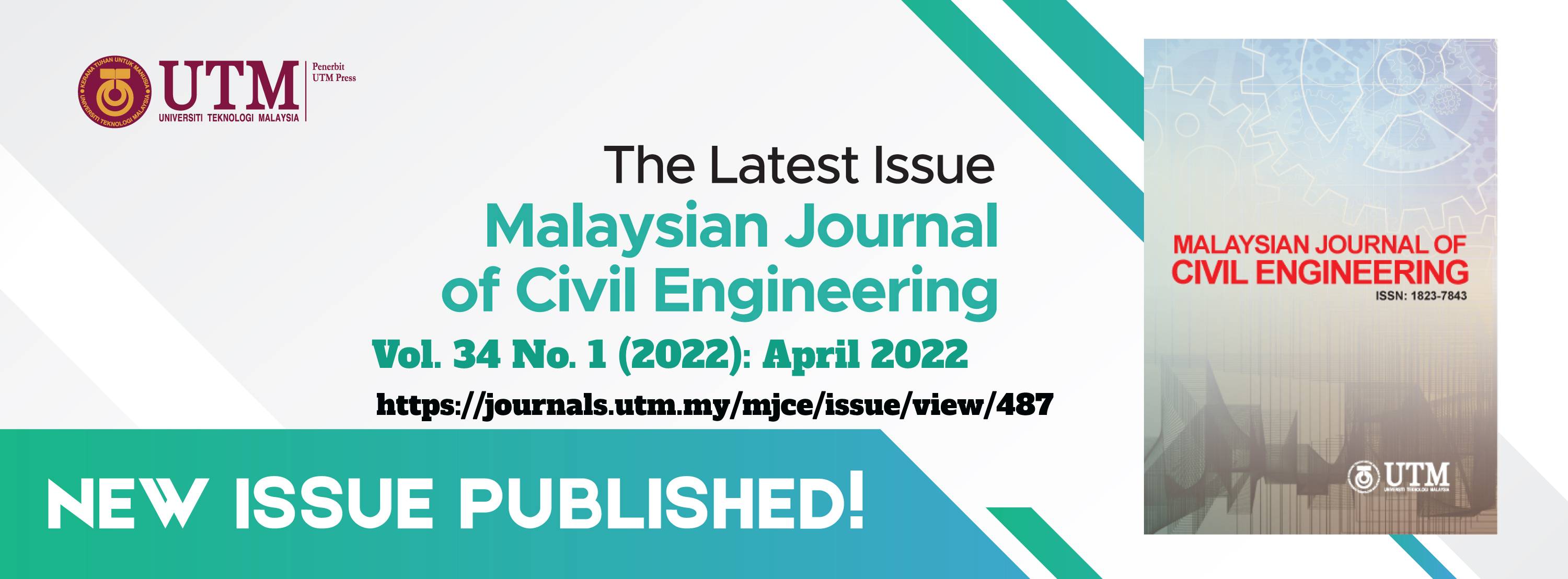RELIABILITY-BASED INVESTIGATION ON THE COMPRESSIVE STRENGTH OF COMMONLY USED NIGERIAN TIMBER SPECIES
DOI:
https://doi.org/10.11113/mjce.v34.17136Keywords:
Axial capacity, Compressive members, First Order Reliability Method, Nigerian-grown timber, Probability of failure, Reliability assessment.Abstract
This paper considers the compressive strength both parallel and perpendicular to grain of not less than twenty Nigerian-grown timber species out of which, six commonly used ones were selected and their compressive resistance assessed under certain loads. First, it was found out that the basic compressive stress perpendicular to the grain of timber is about 22% of the basic compressive stress parallel to grain. A reliability assessment was then carried out using the First Order Reliability Method (FORM) to investigate the performance of a column section of 250 x 250mm and 300 x 300mm for the six Nigerian-grown timber species. Lophira alata was found to be the most reliable with a Probability of failure Pf = 2.78 x 10-3 and 7.1 x 10-2 under an axial load of 1000kN and 2000kN respectively. This was followed by Anogeissus leiocarpus with Pf = 2.53 x 10-2 and 5.26 x 10-3 under an axial load of 1000kN and 1500kN respectively. Others that followed were ‘Iroko’(Chlorophora excelsa),‘Abura’ (Mitragyna ciliata),‘Afara’ (Terminalia superba), and ‘Obeche’(Triplochiton scleroxylon), in the order of descending performance. It can been established from this study that, ‘Ekki’ (Lophira alata) and African birch (Anogeissus leiocarpus) could be suitable for bridge piles and piers, railways or related structures that require compressive members with high axial capacity whereas, ‘Abura’, ‘Obeche’, ‘Afara’ and ‘Abura’ would be best suitable for buildings.
References
Afolayan, J. O., Opeyemi, D. A. 2010. Reliability Analysis of Static Pile Capacity for Concrete and Steel in Cohesionless Soils. Electronic Journal of Geotechnical Engineering, 15:311-319.
Aguwa, J. I. and Sadiku, S 2011. Reliability studies on Nigerian Ekki (Lophira alata) Timber as Bridge Beam in Bending under the Ultimate limit state of loading. Journal of Civil Engineering and Construction Technology. 11, 253-259.
Aguwa, J. I. 2012. Reliability Assessment of Nigerian Apa (Afzelia bipindensis) Timber Bridge Beam Subjected to Bending and Deflection under the Ultimate limit state of loading. International Journal of Engineering and Technology, 2(6): 1076-1088.
Aguwa, J. I. 2016. The Nigerian Structural Timber. Published and Printed by Ahmadu Bello University Press Ltd., Samaru, Zaria. Nigeria. ISBN: 978-978-54683-2-5, 5 and 6.
Benu, M. J., Sule, S. and Nwofor, T. C. 2012. Reliabilility Analysis of a Square Solid Timber Column. Advances in Applied Science Research, 3 (4): 1997-2004.
Beech E., Rivers M., Oldfield S., Smith P. P., 2017. GlobalTreeSearch: The First Complete Global database of tree species and Country Distributions. Journal of Sustainable Forestry, 36(5): 454-489
Bello A. A., Jimoh A. A. 2018. Some Physical and Mechanical Properties of African Birch (Anogeissus leiocarpus) Timber. Journal of Applied Science and Environmental Management, 22 (1): 79-84.
BS 373. 1957. Methods of Testing Small Clear Specimens of Timber, British Standards Institution, 2 Park Street, London WIA 2BS.
BS 5268. 2002. The Structural Use of Timber part 2; for Permissible Stresses, Materials and Workmanship, 5th Edition British Standards Institution, 2 Park Street, London WIA 2BS, 176p.
EN 338. 2009. Structural Timber –Strength Classes. Eurpoean Committee for Standardisation. Austrian Standaard Institute. Heinestrase 38, 1020 Wien.
FAO 2010 Global Forest Resources Assessment 2010. Main Report, FAO Forestry Paper 163. 378.
Wiesner F. and Bisby L. 2019.The structural capacity of laminated timber compression elements in fire: A meta-analysis. Fire Safety Journal, 107: 114-125.
Hasofer A. M., Neils L. 1974. An Exact and Invariant First Order Reliability Format. Journal of Engineering Mechanics. 100(1): 111-121
Jimoh A. A., Aina S. T. 2017. Characterisation and Grading of Two Selected Timber Species grown in Kwara State Nigeria. Nigerian Journal of Technology, (36)4: 1002-1009.
Jimoh A. A., Ibitolu B. J. 2018. Characterisation and Grading of Three Selected Timber Species grown in Kwara State Nigeria according to EN 338 (2009) for Structural Use. Nigerian Journal of Technology, (37)2: 322-329.
Jimoh A. A., Rahmon R. O., Joseph S. G. 2017. Evaluation of Compressive Strength Characteristics of Structural-sized Apa (Afzelia bipindensis) and Opon (Lannea schimperi) Timber species columns found in Nigeria. Journal of Applied Science and Environmental Management. 21(7): 1281-1285.
NCP 2. 1973. The Use of Timber for Construction, Nigerian Standard Organization, Federal Ministry of Industries, Lagos, Nigeria.
NKB 1978. Recommendations for Loadings and Safety Regulations for Structural Designs, Nordic Committee for Building Regulation, Report No. 36.
Nowak A. S., Collins K. R. 2000. Reliability of Structures, McGraw-Hill Companies, USA. 337.
Oluyege, A. O 2007. Wood: A Versatile Material for Natural Development. Inaugural Lecture Series 45, delivered at the Federal University of Technology Akure.
Osama A. B. Hassan 2019 On the structural stability of timber members to Eurocode, Mechanics Based Design of Structures and Machines, 47(5): 647-657.
Abubakar P., Iorkar A., Adedeji A. A., Aguwa J. I., Wilson U. N. 2020. Structural Reliability-based assessment of Nigerian Anogeissus schimperri Timber Bridge beam in shear and bearing forces. Nigerian Journal of Technology, (39)4: 1011-1020.
Song, Y. J., and Hong, S. 2019. Compressive Strength Properties Perpendicular to the Grain of Larch Cross-laminated timber. BioRes. 14(2): 4304-4315.
Wilson U. N., Adedeji A. A., Sani J. E., Alomaja J. A. 2018. A Reliability-Based Design of Nigerian-Grown African Birch (Anogeissus leiocarpus) Solid Timber Column. Epistemics in Science, Engineering and Technology. 8(1): 587-592
















